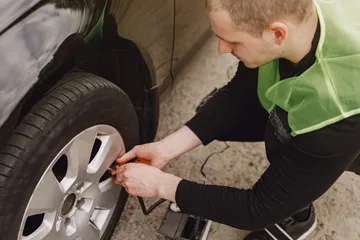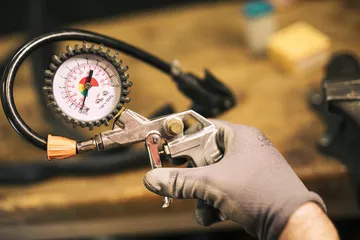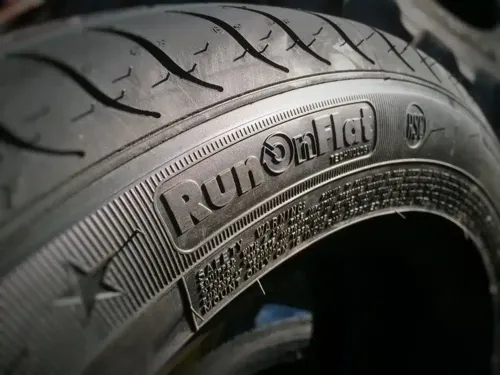How to put air in your tyres?
Learn how to safely and effectively check and inflate your tyres.
Posted on

Keeping your tyres properly inflated is essential for vehicle safety, fuel efficiency, and overall performance. Under-inflated tyres can lead to poor handling, decreased mileage, and even tyre blowouts. Follow this simple guide to make sure your tyres are always at the correct pressure
Step 1: Check the Recommended Tyre Pressure
Before you start inflating your tyres, you need to know the correct pressure. You can find the recommended tyre pressure in a few places:
- Your Vehicle’s Manual: The manual will indicate the optimal tyre pressure for your specific vehicle model.
- Driver’s Side Door Jamb: Many cars have a sticker on the inside of the driver’s side door that lists the recommended pressure.
- Tyre Itself: Some tyres have the maximum PSI (pounds per square inch) listed on the sidewall, though this is not necessarily the recommended pressure for everyday driving.
Make sure to check whether the recommendation is different for the front and rear tyres.
Step 2: Prepare the Necessary Tools

To put air in your tyres, you'll need:
- A Tyre Pressure Gauge: This tool helps you measure the current air pressure in your tyres.
- Air Compressor: You can find air compressors at most petrol stations, or you can purchase a portable one for home use.
- Valve Caps: Make sure your tyre valve caps are present before starting, as they help maintain pressure after inflation.
Step 3: Check the Current Tyre Pressure
Before adding air, you need to check the current pressure to see how much air is required. Here’s how to do it:
- Remove the valve cap from the tyre's valve stem.
- Place the tyre pressure gauge firmly on the valve stem to get a reading.
- Compare the reading with the recommended pressure for your vehicle.
If your tyre is under-inflated, proceed to the next step to add air.
Step 4: Add Air to Your Tyres
Now that you know the current pressure, it’s time to add air:
- Attach the air compressor nozzle to the valve stem. You’ll hear a slight hissing sound as air moves into the tyre.
- Inflate the tyre in short bursts to avoid over-inflation. Many air pumps have a built-in gauge, but if yours doesn’t, stop and check with your own pressure gauge frequently.
- Recheck the pressure after each burst to ensure you don’t exceed the recommended PSI.
- Once the tyre reaches the recommended pressure, remove the air hose and quickly screw the valve cap back onto the tyre.
Step 5: Repeat for All Tyres
Repeat the process for all four tyres. Make sure to check each tyre’s pressure individually, as they may not all require the same amount of air. Don’t forget to also check your spare tyre—keeping it properly inflated is just as important in case of emergencies.
Step 6: Double-Check for Leaks
After inflating all tyres, it's a good idea to check for any leaks. You can do this by:
- Listening for a hissing sound around the valve or tyre surface.
- Applying a small amount of soapy water to the valve stem and tyre surface. If bubbles form, there may be a leak, and you should have the tyre inspected or repaired.
Step 7: Check Tyre Pressure Regularly
Tyre pressure fluctuates with temperature and general use, so it’s important to check your tyres monthly or before long trips. Keeping your tyres inflated to the recommended pressure ensures they wear evenly and last longer, saving you money on replacements.
Final Tips:
- Avoid over-inflating your tyres, as this can cause poor handling and increase the risk of blowouts.
- Tyre pressure may decrease in cold weather, so check your tyres more frequently in winter.
- If you don’t have access to a compressor at home, most petrol stations offer air pumps for a small fee or even for free.
Why Proper Tyre Inflation Matters:
Maintaining the correct tyre pressure ensures:
- Better Fuel Efficiency: Under-inflated tyres can reduce fuel efficiency, leading to higher costs at the pump.
- Longer Tyre Life: Properly inflated tyres wear more evenly, extending their lifespan.
- Improved Safety: Correct tyre pressure improves handling, reduces braking distance, and lowers the risk of tyre failure.
By following these simple steps, you can ensure that your tyres are always at the right pressure, improving your driving experience and keeping you safe on the road. Regular tyre maintenance is a small task that can save you from bigger issues down the line.










